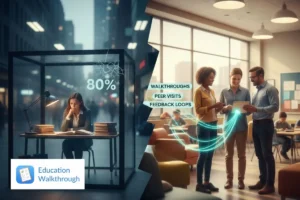In today’s educational setting, it’s vital for educators to consistently observe and assess classroom practices to drive improvement. One key area that’s garnering attention is the integration of technology in classrooms. For educators to effectively use technology, having a tool to monitor and assess its use becomes crucial. This is where the International Society for Technology in Education’s (ISTE) Classroom Observation Tool (ICOT) comes into play.
Why is Classroom Technology Integration Essential?
Integrating technology into classrooms isn’t just a trend, it’s a necessity. As noted by Al-Bataineh and his colleagues in 2008, the effective incorporation of technology is a foundational skill that educators need to master to ensure their teaching success. This integration has reshaped learning, offering both students and educators an enriched learning experience.
What is ICOT and Why Is It Important?
Developed in collaboration with Hewlett Packard, ICOT is a tool devised by ISTE. This digital note-taking application can be utilized on both Windows and Macintosh systems. It aids observers in evaluating:
- Student grouping: individual, pairs, whole class.
- The roles teachers adopt: from lecturing to facilitating.
- The learning activities happening in class.
- The specific technologies being used.
- Duration of technology usage.
- Engagement levels of the students.
A Glimpse Into A Classroom Observation Using ICOT
On a day in September 2023, an 11th-grade language arts classroom was observed for nearly an hour. The main objective was to evaluate how well technology was being integrated and how effective the ICOT tool was in assessing this.
Here’s a snapshot of the classroom setting:
- No student computers were present, but a teacher’s laptop, document camera, and digital projector were in use.
- Students interacted with questions displayed via the projector using their personal digital devices.
- The class involved activities such as quizzes and games that were integrated with technology, promoting active learning.
Using ICOT, the observer could detail all the roles the teacher played, from being a lecturer to facilitating discussions. The tool also highlighted the efficiency of technology use — with 92% of the students remaining engaged throughout.
Benefits of Using ICOT for Observations
For those unfamiliar with ICOT, there might be a learning curve, but the advantages are numerous:
- Comprehensive Assessment: ICOT provides a detailed breakdown of everything happening in the classroom, from teacher roles to the technologies in use.
- Promotes Peer Observations: It’s not just for external observations. ICOT can be a valuable tool for educators observing their peers, a practice that can enhance the teaching process.
- Alignment with Standards: ICOT also ensures that technological use aligns with the National Educational Technology Standards (NETS), ensuring quality education.
In conclusion, for educators aiming to effectively integrate technology, tools like ICOT can provide invaluable insights. While technology in classrooms is growing, it’s essential to ensure it’s being used effectively, and ICOT is a step in the right direction.
References:
- Al-Bataineh, A., et al. (2008). A study of technology integration in the classroom.
- Bielefeldt, T. (2012). Guidance for technology decisions from classroom observation.
- Cowan, J. E. (2008). Integrating technology into the classroom.
- International Society for Technology in Education. (2012). ISTE classroom observation tool.



